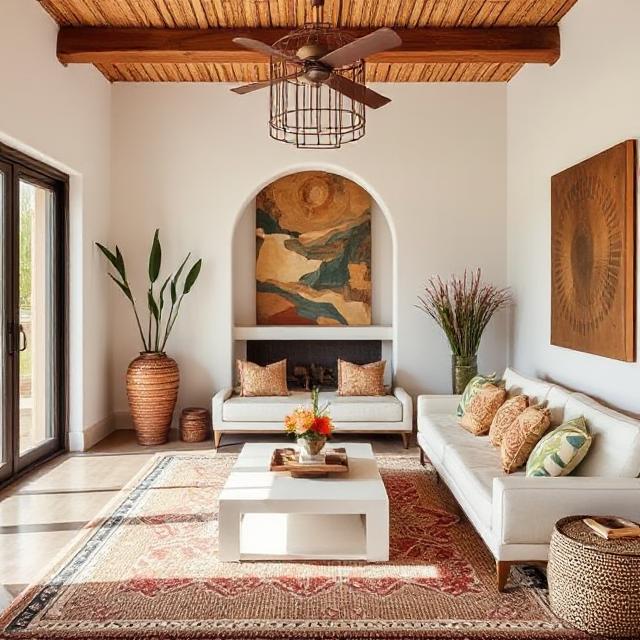Introduction to Modern Mexican Interior Design
In recent years, interior design has evolved to embrace diverse cultural influences, and Mexican design is at the forefront of this vibrant movement. Modern Mexican interior design masterfully blends traditional elements with contemporary aesthetics, creating spaces that are warm, colorful, and full of personality. This style celebrates Mexico’s rich cultural heritage while incorporating modern functionality and minimalism, resulting in interiors that are both timeless and fresh.
The Essence of Modern Mexican Interior Design
At its core, modern Mexican interior design embodies a celebration of Mexico’s history, artistry, and natural environment. It draws inspiration from indigenous crafts, colonial architecture, and the country’s diverse landscapes. The style is characterized by a bold use of color, organic textures, handcrafted details, and an emphasis on natural materials.
Unlike traditional Mexican decor, which can sometimes lean toward overly ornate or rustic, modern Mexican design seeks a balance—integrating traditional motifs with sleek lines and contemporary furnishings. This fusion results in spaces that feel both rooted in tradition and aligned with current design trends.
Color Palette: Vibrancy and Warmth
Color plays a pivotal role in modern Mexican interiors Design. Bright, saturated hues such as terracotta, turquoise, saffron, deep reds, and emerald greens are commonly used to evoke the lively spirit of Mexican culture. These colors are often paired with neutral tones like white, beige, or gray to create a balanced and sophisticated look.
The walls might be painted in bold hues or adorned with colorful tiles, while textiles such as cushions, rugs, and curtains add layers of color and texture. The strategic use of color not only energizes the space but also pays homage to Mexico’s vibrant festivals, markets, and traditional art.
Materials and Textures: Nature-Inspired and Handcrafted
Natural materials are fundamental in modern Mexican design. Terracotta, clay, wood, and stone are frequently incorporated, reflecting Mexico’s rich artisanal heritage. Handcrafted pottery, woven textiles, and intricate embroidery are used as decorative accents, adding authenticity and tactile interest to interiors.
Textural contrast is key—smooth glazed ceramics juxtaposed with rough-hewn wooden furniture, or sleek modern metals paired with rustic woven baskets. These combinations create a layered, inviting atmosphere that feels both curated and organic.
Furniture and Layout: Simplicity with Cultural Flair
Modern Mexican interior Design favor furniture with clean lines and functional forms, often made from natural materials. Wooden benches, carved chairs, and low-slung sofas upholstered in vibrant textiles are common features. The furniture often incorporates handcrafted details, such as carved patterns or painted motifs, giving a nod to traditional Mexican craftsmanship.
Open floor plans are typical, allowing for easy movement and a sense of spaciousness. Central courtyards or patios are frequently integrated into home designs, bringing the outdoors in and emphasizing Mexico’s love of indoor-outdoor living.
Decorative Elements: Art, Textiles, and Artisanship
Decorative accents are where modern Mexican interior Design truly shine. Artworks inspired by Mexican folk art, murals, or contemporary pieces by local artists add personality and cultural depth. Woven rugs, embroidered cushions, and colorful ceramics serve as focal points.
Handmade textiles, such as serapes, rebozos, or embroidered tablecloths, introduce intricate patterns and vibrant colors. Talavera tiles—distinctive glazed ceramics with intricate patterns—are iconic and often used for backsplashes, flooring, or decorative accents.
Statues, pottery, and metalwork—like wrought iron light fixtures or decorative grilles—enhance the authentic feel. Plants—especially cacti, succulents, and lush greenery—bring life and connect the interior to Mexico’s diverse landscapes.
Lighting: Warm and Inviting
Lighting in modern Mexican interior Design to enhance the warm color palette and textured surfaces. Pendant lamps made of woven fibers, wrought iron chandeliers, and lanterns create a cozy, inviting atmosphere. Natural light is maximized through large windows and open spaces, emphasizing the connection with the outdoors.
Sustainable and Ethical Design
Modern Mexican interior design also aligns with global trends toward sustainability and ethical sourcing. Many designers incorporate reclaimed wood, recycled tiles, and eco-friendly textiles. Supporting local artisans and craftsmen is a key principle, ensuring that traditional skills are preserved and that the style remains authentic and socially responsible.
Creating a Modern Mexican Space
To achieve a modern Mexican interior Design, consider the following tips:
- Start with a neutral base—white or beige walls provide a canvas for vibrant accents.
- Incorporate bold colors through textiles, artwork, and accessories.
- Use natural and handcrafted materials—wood, clay, woven fibers—to add texture.
- Select furniture with simple lines but add handcrafted details or vibrant upholstery.
- Display Mexican art and crafts to add cultural authenticity.
- Integrate indoor plants for freshness and vitality.
- Emphasize natural light and open layouts for a relaxed, inviting feel.
Conclusion
Modern Mexican interior design is more than just a style; it’s a celebration of cultural identity expressed through color, texture, and craftsmanship. It harmoniously blends tradition with contemporary sensibilities, creating spaces that are lively, inviting, and deeply rooted in Mexico’s rich heritage. Whether in a city apartment or a countryside villa, this aesthetic offers a warm and colorful retreat that honors Mexico’s past while embracing the future. As global appreciation for authentic and culturally rich design continues to grow, modern Mexican interior Design stand out as a vibrant example of how tradition and innovation can coexist beautifully in the modern home.



